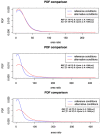Investigating the effects of storage conditions on urinary volatilomes for their reliability in disease diagnosis
- PMID: 38148934
- PMCID: PMC10749378
Investigating the effects of storage conditions on urinary volatilomes for their reliability in disease diagnosis
Abstract
Background: Cancer detection presents challenges regarding invasiveness, cost, and reliability. As a result, exploring alternative diagnostic methods holds significant clinical importance. Urinary metabolomic profiling has emerged as a promising avenue; however, its application for cancer diagnosis may be influenced by sample preparation or storage conditions.
Objective: This study aimed to assess the impact of sample storage and processing conditions on urinary volatile organic compounds (VOCs) profiles and establish a robust standard operating procedure (SOP) for such diagnostic applications.
Methods: Five key variables were investigated: storage temperatures, durations, freeze-thaw cycles, sample collection conditions, and sample amounts. The analysis of VOCs involved stir bar sorptive extraction coupled with thermal desorption-gas chromatography/mass spectrometry (SBSE-TD-GC-MS), with compound identification facilitated by the National Institute of Standards and Technology Library (NIST). Extensive statistical analysis, including combined scatterplot and response surface (CSRS) plots, partial least squares-discriminant analysis (PLS-DA), and probability density function plots (PDFs), were employed to study the effects of the factors.
Results: Our findings revealed that urine storage duration, sample amount, temperature, and fasting/non-fasting sample collection did not significantly impact urinary metabolite profiles. This suggests flexibility in urine sample collection conditions, enabling individuals to contribute samples under varying circumstances. However, the influence of freeze-thaw cycles was evident, as VOC profiles exhibited distinct clustering patterns based on the number of cycles. This emphasizes the effect of freeze-thaw cycles on the integrity of urinary profiles.
Conclusions: The developed SOP integrating SBSE-TD-GC-MS and statistical analyses can serve as a valuable tool for analyzing urinary organic compounds with minimal preparation and sensitive detection. The findings also support that urinary VOCs for cancer screening and diagnosis could be a feasible alternative offering a robust, non-invasive, and sensitive approach for cancer screening.
Keywords: SBSE-GC-MS; metabolomics; standard operating procedures; urinary biomarkers; volatile organic compounds.
AJCEU Copyright © 2023.
Conflict of interest statement
None.
Figures










References
-
- Abate-Shen C, Shen MM. Diagnostics: the prostate-cancer metabolome. Nature. 2009;457:799–800. - PubMed
-
- Silva CL, Passos M, Câmara JS. Solid phase microextraction, mass spectrometry and metabolomic approaches for detection of potential urinary cancer biomarkers--a powerful strategy for breast cancer diagnosis. Talanta. 2012;89:360–368. - PubMed
-
- Srivastava A, Creek DJ. Discovery and validation of clinical biomarkers of cancer: a review combining metabolomics and proteomics. Proteomics. 2019;19:e1700448. - PubMed
-
- Sole C, Arnaiz E, Manterola L, Otaegui D, Lawrie CH. The circulating transcriptome as a source of cancer liquid biopsy biomarkers. Semin Cancer Biol. 2019;58:100–108. - PubMed
Grants and funding
LinkOut - more resources
Full Text Sources
Research Materials
Miscellaneous
